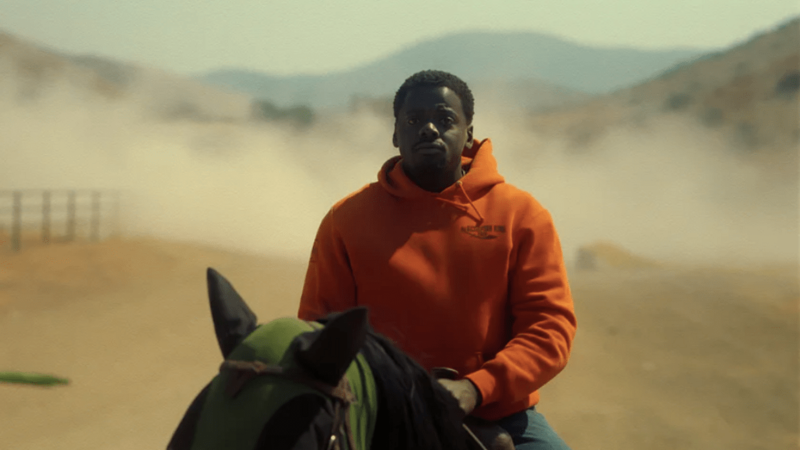
According to its production notes, Jordan Peele's Nope is a new take on "the granddaddy of genre movies: the summer event film." Saying this out loud sets a pretty high bar for the picture to clear. When you think back on the classics of the sci-fi/fantasy tradition—the neighborhood into which Nope hopes to move—you recall the all-time hits: Spielberg's Jaws (the original summer blockbuster, released in June 1975), John Carpenter's The Thing (June 1982), and Roland Emmerich's Independence Day (July 1996). These movies are still vibrantly alive—on streaming sites and in theatrical revivals—because they're filled with images (an inside-out demon dog, a space alien being punched in the snoot) and scenes (Robert Shaw's haunting monologue about a World War II shark attack) that people still talk about.
That Nope is unlikely to join this celebrated company is a disappointment, because Peele, a director of distinctive gifts with a cheerful affection for the B-movie tradition, achieved wonderful things with his first two features, fusing horror and sizzling cultural satire in the 2017 Get Out (for which he won an Oscar for Best Original Screenplay) and the scary but muddled Us (2019). Now, with Nope, he extends his creative reach, attempting to take in Hollywood class and race arrangements as well, while at the same time delivering a full-on, 1950s-style flying-saucer movie. This sounds like a fresh kind of fun, and the director does in fact assemble some wild sights for us. But the movie's concept never quite gels and the story doesn't knit together, and since the picture is overlong (at two and a half hours), we're given too much time to notice these things.
The action is set in the dusty hills outside Los Angeles, where OJ Haywood (Get Out star Daniel Kaluuya) maintains a family ranch where he and his sister Emerald (Keke Palmer) train horses for film and TV work. It's the only such black-owned business in the industry, but the introspective OJ is thinking about accepting an offer to sell it now that his father (Keith David, who was actually in The Thing) has been killed in a mysterious downpour of junk (coins, keys, etc.) that suddenly came plummeting down out of the sky one day.
This incident turns out to be connected to a UFO hiding behind a cloud high up in the sky. The possibilities for profiting from this extraterrestrial visitation quickly occur to the Haywoods' neighbor, Ricky Park (Steven Yeun), a childhood sitcom star who runs a tourist attraction—a replica of a California Gold Rush town—on his property and still harbors a desire to get back in the showbiz game. For their part, OJ and Emerald decide it might behoove them to document the elusive saucer on film, to which end they recruit the assistance of electronics whiz and UFO buff Angel Torres (Brandon Perea) and moonlighting cinematographer Antlers Holst (Michael Wincott—of Alien: Resurrection!), whose surname, one can't help suspecting, might be a no-particular-reason hat tip to Gustav Holst, composer of the outer-spacey orchestral suite, The Planets. Apologies for even thinking that.
The movie's grabbiest scenes feature a chimpanzee, of all things, and a spooky little-gray-men visitation. The saucer action is well-done, too—the huge thing zips around more gracefully than is usual in these sorts of films, and it acquires an increasingly persuasive "reality" the closer we get to it. There are also some resonant narrative touches, like the notion that the Haywoods are descended from the anonymous black jockey seen riding a horse in the famous 1898 stop-motion photo series that prefigured the birth of motion pictures: Here, Peele gives him a (fictitious) name at last. And finally, any showbizzer who's ever been the target of a TMZ celebrity ambush will surely appreciate the violent payback that Peele exacts in this film.
The movie's shortcomings—offered here with as little spoilage as possible—include the failure of the script (written by Peele) to make certain story connections that must instead be puzzled out by the viewer. There's a key revelation at one point that is visually ungainly, and the dialogue throughout is over-abundant—characters keep talking even after they have anything illuminating left to say. (A related problem is that Kaluuya plays his character as such an introvert that he sometimes seems like an observer rather than a participant in the action, which enables Palmer to be overly effusive.) The picture is also burdened by the bright sunlight and dun-colored environments in which it was shot—despite the colorful Gold Rush town and some cooling, shady interiors, visual interest, even with IMAX cameras weighing in, is often minimal.
Mainly, it's too bad the story here isn't more involving: It doesn't pull you in or pull you along—it feels as if its attention is divided among too many competing objectives. The narrative is labored in spots—it spreads out when it should come to a point. One final problem: Given that this species of sci-fi is nominally a part of the horror universe, it doesn't help that, unlike Jaws, The Thing, and Independence Day, Nope is never scary. Which—very sad to say—makes it Jordan Peele's third-best film.
The post Review: <em>Nope</em> appeared first on Reason.com.







